The Mosque of Córdoba is the city's great monument and its main tourist attraction.
What's more, it is one of the most impressive monuments you can visit in Spain, which is easy to understand when in its time it became the second largest mosque in the world.
La Mosque of Cordoba It is a declared monument Heritage awarded by the Unesco, and your visit should be a must in a tourist trip through Andalusia.
Completed in the year 988, the Mosque of Cordoba It is the expression of the greatness of the dynasty Omeya, and had a capacity for 30.000 parishioners.
These made their prayer in their famous and endless forest of columns.
In your visit of the Mosque of Córdoba you will see archaeological remains of an initial visigothic church, or you will also enjoy the great architectural beauty of the old areas macura y mihrab of the mosque.
And you will also discover surprising corners, such as the gothic ship of the 13th century and, above all, the imposing renaissance style basilica which in the 16th century was inserted in the very center of the old muslim mosque, which has since made it the Christian cathedral of Córdoba.
In view of your visit, at the outset it will be useful for you to know the following curiosities about the history of the Mosque of Córdoba that we leave you in this article.
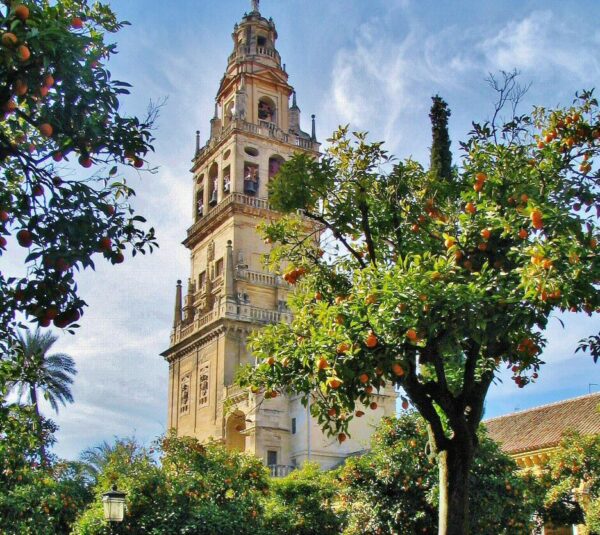
And below we are going to highlight the main corners that you will see during your visit to this great monument.
All the information in detail
- 1 The best things to see when visiting the Mosque of Córdoba
- 2 Doors of Al Hakam II in the Mosque of Córdoba
- 3 Door of Forgiveness in the Mosque of Córdoba
- 4 Courtyard of the Orange Trees in the Mosque of Córdoba
- 5 Remains of the old Visigoth church in the Mosque of Córdoba
- 6 Gothic nave in the Mosque of Córdoba
- 7 Mihrab and macsura of the Mosque of Córdoba
- 8 Christian basilica in Mosque of Córdoba
- 9 Visiting times for the Mosque of Córdoba
- 10 Córdoba Mosque ticket prices
- 11 Guided tours of the Mosque of Córdoba
The best things to see when visiting the Mosque of Córdoba
Your visit to this great monument will actually begin with a tour of the exterior of the walled enclosure that protects the Patio de los Naranjos and where you will have access to the interior of the mosque.
To begin with, in it you must see the old mosque doors known as Gates of Al Hakam II.
Doors of Al Hakam II in the Mosque of Córdoba
You can find these old doors on the west façade, in its southernmost part, next to the monument known as the Triumph of Saint Raphael, almost in front of the Roman Bridge of Cordoba.
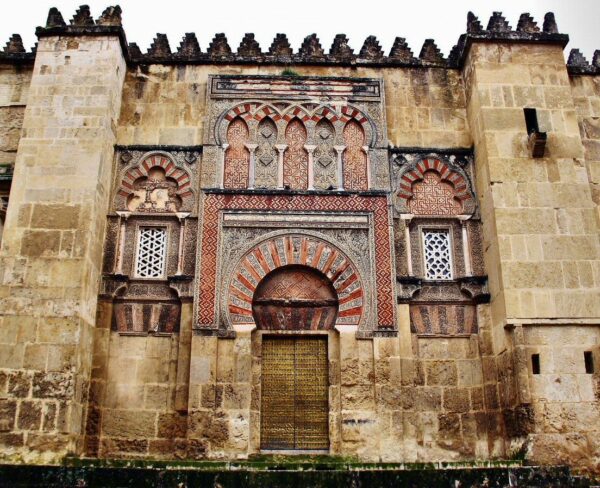
You will find them without problem if you come from Alcazar of the Christian Monarchs.
This area of the Mosque of Cordoba It is the result of the most important extension that was made of it, the one carried out by Al Hakam II during the 10th century, which represented the time of greatest splendor of the Caliphate of Córdoba.
The so-called Gates of Al Hakam II They are two adjacent entrances, of very similar design, and are the best example of the splendid decoration of the andalusian architecture what you can see on the outside of the Mosque of Cordoba.
Both doors of the old mosque are also known by the Christian name of Door of the Holy Spirit y Gate of San Ildefonso.
They were boarded up until they were restored at the end of the 19th century and beginning of the 20th century by the architect Velazquez Bosco and the sculptor Mateo Inurria, so that now we can appreciate its great aesthetic beauty.
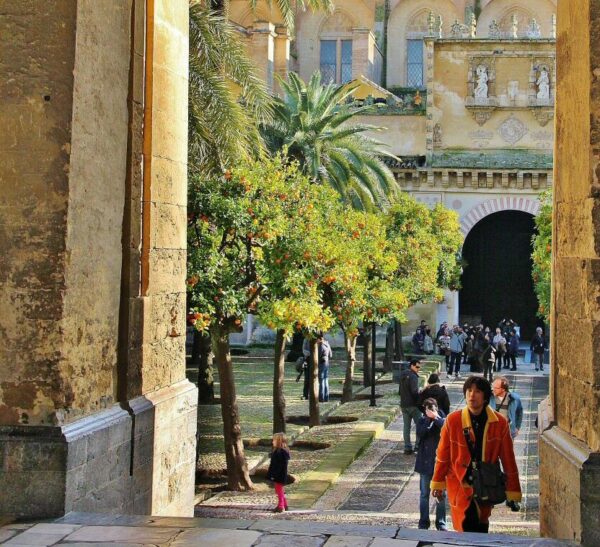
Door of Forgiveness in the Mosque of Córdoba
When you visit the Mosque of Cordoba, you will possibly enter through the Door of Forgiveness to the large garden space that precedes it, the so-called Patio de los Naranjos.
La Door of Forgiveness You find it on the north façade of the wall that surrounds said patio, at the foot of the old muslim minaret, now converted into bell tower, one of the current icons of the city of Cordova.
This is the main access door to the aforementioned Patio de los Naranjos, and is the one used during the festivities of eastern by the brotherhoods to access the cathedral grounds.
La Door of Forgiveness It was built in 1377, during the time of the Castilian king Henry II, from the original door from the 10th century.
ORGANIZE your TRIP
- Don't forget your TRAVEL INSURANCE with a 5% discount
- Book the HOTEL for your trip
- RENT a CAR for your trip
- The best TOURS and EXCURSIONS in Spanish
- NO-LINE TICKETS for museums and monuments
- Best FREE TOURS around the world
- Book your TRANSFER from the airport
- eSIM card with INTERNET at the best price
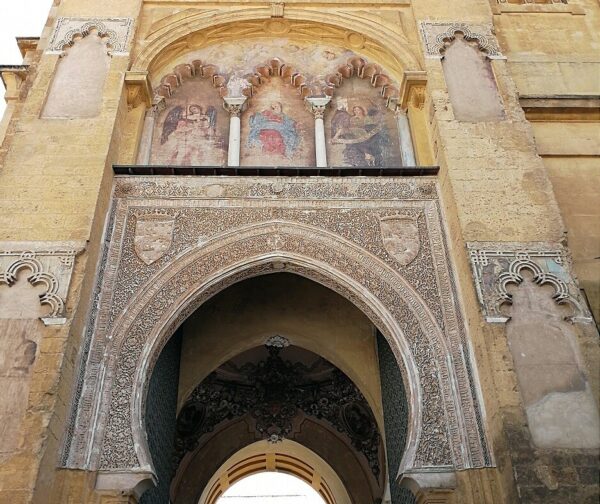
It was a Mudejar style renovation that featured a double portico with an interior enclosure; The two doors, the interior and the exterior, show different horseshoe arches.
The interior area between both doors has a dome that was initially made of brick, but currently you will see an 18th century plasterwork.
Courtyard of the Orange Trees in the Mosque of Córdoba
Once you access the interior of the walled enclosure through the aforementioned Door of Forgiveness, or through one of the other two available doors, you will find yourself in the Patio de los Naranjos.
It is a large patio where you can see almost a hundred orange trees in rows that were planted in the 17th century.
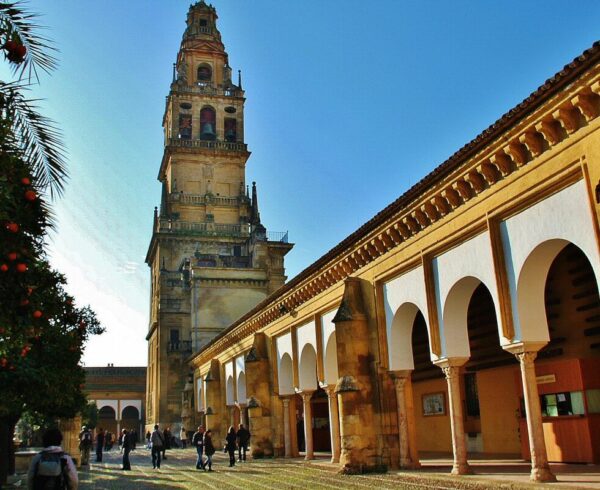
Its current dimensions correspond to the extension carried out at the beginning of the 10th century, and to access it our advice would be to do so through the Saint Catherine's Gate, well there you have the best view of the bell tower with the orange trees in the foreground.
Remains of the old Visigoth church in the Mosque of Córdoba
When you begin the tour inside the building, upon entering on the right side you will see a railing on the floor that delimits a gap covered by a glass window, where some archaeological excavations.
Is archaeological remains of the church of San Vicentea christian visigothic church which was located in the place where around the year 780 the first phase of the city began to be built. Umayyad Mosque.
Indeed, perhaps you do not know that the Mosque of Cordoba It was built on the remains of an ancient visigothic church which was built in the middle of the 6th century, and which at that time became the main Christian temple of the city of Cordova.
After the occupation of Cordova by the Arabs during the 8th century, the Visigothic church of San Vicente It began to be shared for religious use by Christians and Arabs.
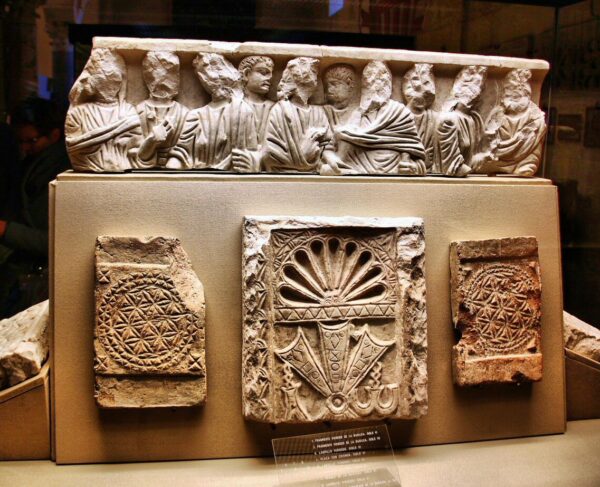
This shared use of the temple of Visigothic origin was maintained until, during the reign of Abderraman I, The convenience of building a mosque was considered, which meant the disappearance of the church of San Vicente.
It was not until the period between 1930 and 1936 when excavations in the oldest area of the Mosque of Cordoba, the order to build by Abderraman I, which allowed us to discover archaeological remains of the disappeared Visigoth church.
Apart from the aforementioned hole in the floor that you can see when starting the visit of the Mosque, in the background to the right of the temple, in the area corresponding to the expansion carried out by Al Hakam II, you will be able to see some showcases.
Capitals, pillars and mosaics are exhibited there, as well as other objects with Christian iconography that were brought to light during the excavations.
This area of the old mosque is currently known as the Visigothic Museum of San Vicente.

The vast majority of ancient temples usually have a long history not only due to architectural reconstructions, with changes in style, but also due to their different religious cults.
Thus, it is common for a Christian church initially in Romanesque style to be rebuilt in Gothic style and even later incorporate Renaissance or Baroque elements.
And it also happens that where a Roman temple was located, a mosque is built and then a Christian church.
In the case of the Mosque of Cordoba, this evolution led to the construction of the christian basilica, headquarters of the cathedral of cordoba, but also other corners of Christian origin, in addition to those mentioned archaeological remains of the Visigothic church.
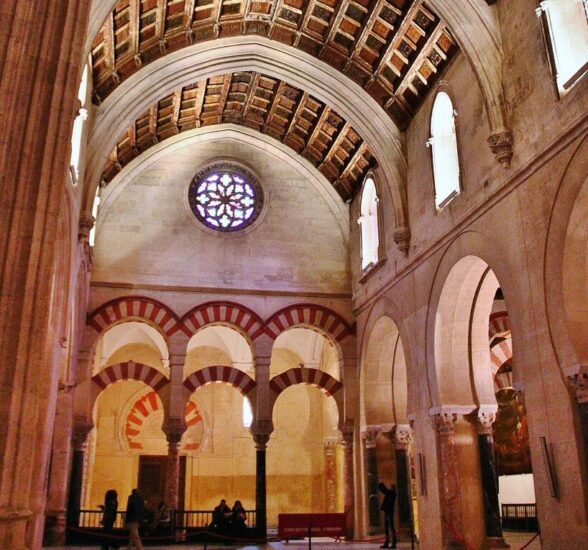
Specifically, the gothic ship where the first Christian reconstruction took place when Ferdinand III of Castile conquered Cordova in 1236 and the muslim mosque was consecrated as christian cathedral.
Don't forget your Travel Insurance
Are you organizing your trip or getaway? Don't leave without take out your travel insurance before, and here we explain why. If you hire it with us, you have a 5% discount
On your walk through the monument you will still be able to see the Gothic-style architectural structure of said first "church" whose main altar occupied the place of the original anteroom of the first mihrab that the mosque had.
This corner currently has the name of Villaviciosa Chapel.
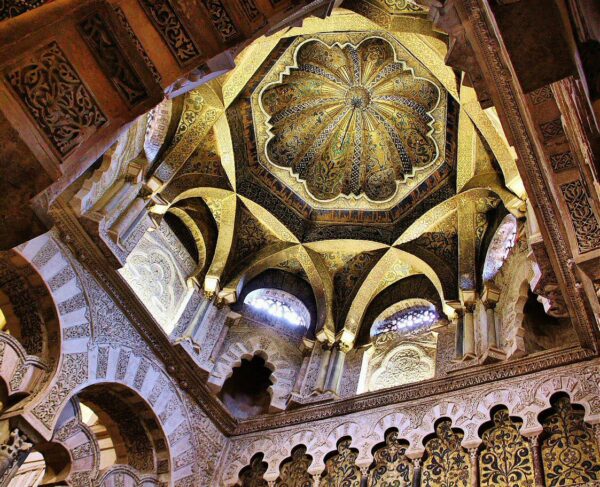
Mihrab and macsura of the Mosque of Córdoba
Without a doubt, the area of greatest architectural beauty in the Mosque of Cordoba is the one occupied by the macura and mihrab, the most sacred precincts of Muslim mosques.
This area was created after the expansion carried out in the Season of Al-Hakam II, which was completed in the year 965.
On your walk through the impressive monument you will find the area of mihrab at the back of the enormous room of the ancient Muslim temple, and it will be easy for you to recognize it because a large number of visitors gather in front of it.
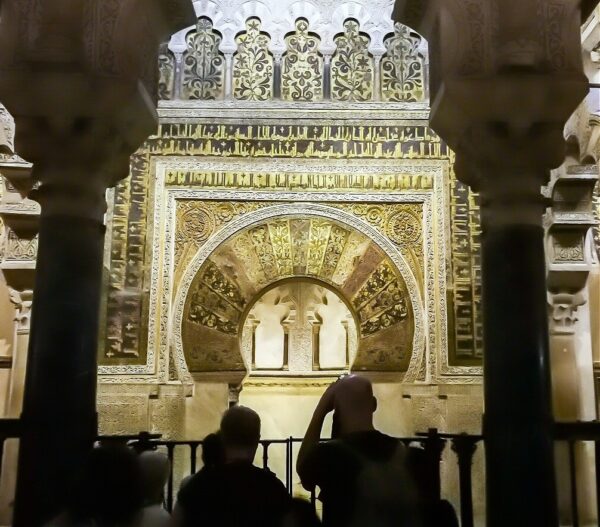
In this area you can see three doors, intertwined arches and three domes, all with spectacular decoration.
In particular, the vault of the mihrab It is made up of eight nerves, and three open in front. skylights.
The tesserae covered in gold also stand out, and as for the cover of the mihrab, is made with marble squares.
Christian basilica in Mosque of Córdoba
An aspect that will surprise you when you see the old mosque is that in the center of the enormous building there is a large renaissance style basilica.
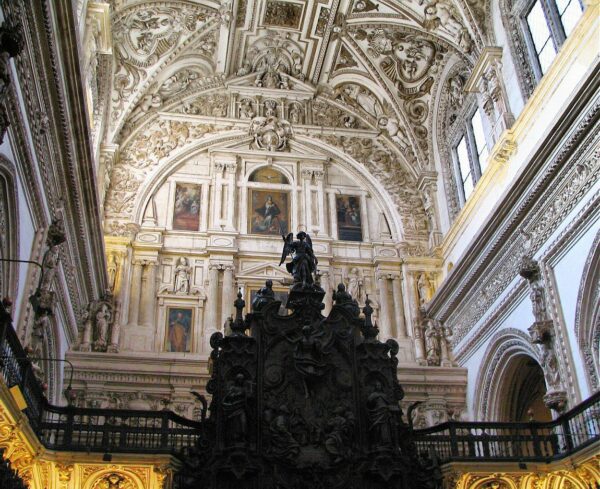
Indeed, during the 16th century a christian cathedral at the wish of the religious authorities of the time, specifically, the bishop Inigo Manrique, to give greater splendor to the Capilla Mayor Built in the 13th century, after the conquest of the city by Ferdinand III The SaintIn 1236.
Together with Capilla Mayor which was located on the site occupied by an old mihrab of the Muslim temple, the aforementioned gothic style nave, an architectural complex that barely modified the structure of the islamic mosque.
On the other hand, you will see that the 16th century Christian cathedral represents a total rupture of its structure, which after its construction provoked severe criticism from the King Charles I.
After having authorized the works and after seeing the result, he is said to have stated: "I didn't know what this was, because I wouldn't have allowed it to go back to the old, because you make what can be found elsewhere and you have thrown away what was unique in the world."
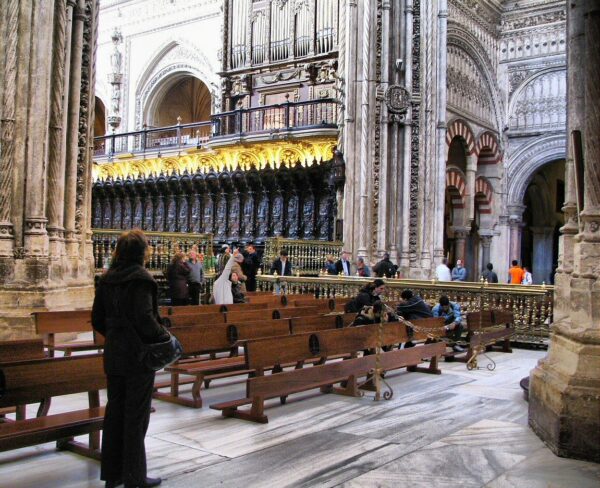
Some of the most significant elements of the renaissance basilica Built in the center of the original mosque, you can already see them from the outside of the building.
I mean the cruise and its domes, which stand out from the rest of the Muslim building.
Book your hotel, 15% discount, free cancellation
When planning your trip, we advise you to, well in advance, Book your hotel now on booking.com where you can find discounts from 15% and you will have a possible cancellation for free
La christian cathedral It is shaped like a cruise, with side naves that take advantage of the naves of the Muslim building.
From the architectural mix, perhaps you squeak the Islamic arches that support the domes.
From the almost complete renaissance basilica for the Mosque of Cordoba, the most distinctive elements are the High altar and Chorus.
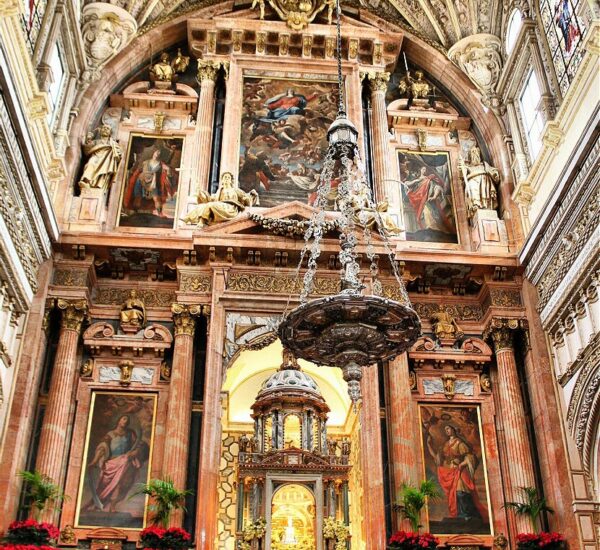
The large altarpiece of the High Altar It was completed in the year 1653.
Work of the Granada Jesuit Alonso Matias, combines marble and bronze, and has a style similar to that of the altarpiece of the Basilica of the Monastery of El Escorial, In the surroundings of Madrid.
For its part, the construction of the choir stalls of the Renaissance basilica It had to be delayed a century, so it was not completed until 1757.
In your visit of the Mosque of Córdoba, behind the large bronze bars you can see the 105 choir chairs, located in two rows, the entire complex with a sumptuous decoration.
In the face of criticism for the undoubted architectural break which in its day involved the construction of an enormous cathedral in the heart of the great jewel of caliphal art, there is an opinion that, thanks to this, the islamic monument has survived to this day.
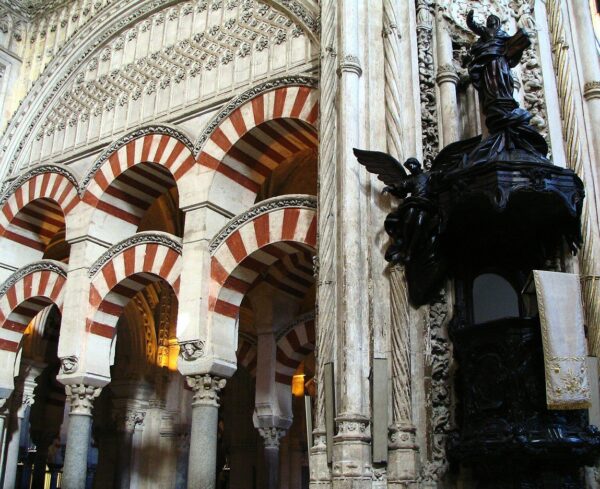
In short, if the Christian cathedral had been built in another location in the city of cordoba, the mosque would have eventually been destroyed, as, for example, happened with the great Seville mosque.
Visiting times for the Mosque of Córdoba
You can visit the Mosque Cathedral of CórdobaIn general, Monday to Friday, from 10 a.m. to 14 p.m. and from 10 a.m. to 19 p.m.; Saturdays, from 10 a.m. to 19 p.m.; and Sundays, from 8,30:11,30 a.m. to 16:19 a.m. and from XNUMX p.m. to XNUMX p.m.
Reserve your RENTAL CAR now for your trip
Looking ahead to your trip, book your rental car now on this website that offers you the best price guaranteed and allows you a possible free cancellation in most cases. Here you have more information with tips for renting a car
But they change depending on the time of year, so we advise you to consult the Visiting hours of the Mosque Cathedral of Córdoba on the specific day you plan to visit the monument.
The last admission for the visit is half an hour before closing time.
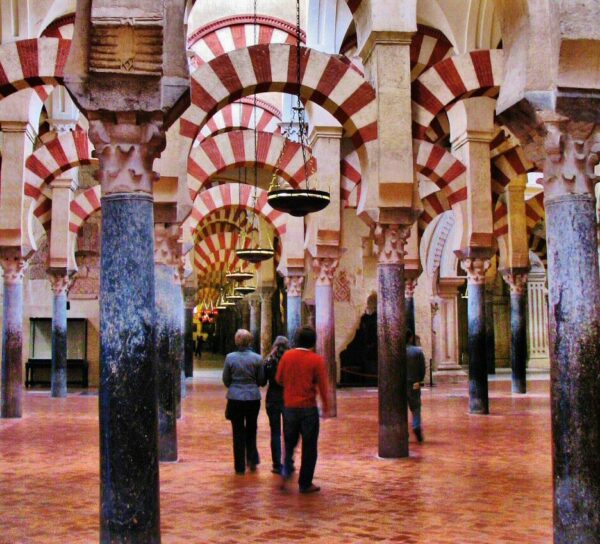
Córdoba Mosque ticket prices
The ticket prices to the Mosque of Córdoba They are 11 euros for adults; 9 euros for seniors+65, students from 15 to 26 years old and holders Youth Card; and 6 euros for children from 10 to 14 years old; 4 euros for members of large families.
But also, you can visit the Mosque of Córdoba for free children under 10 years of age, those born or residing in Córdoba, holders of the Andalucía Junta 65 card and the disabled +64% with a companion.
Guided tours of the Mosque of Córdoba
You also have the option, if you prefer, to make a guided tour in Spanish for this historic place, which is one of the most popular activities among visitors to the city.
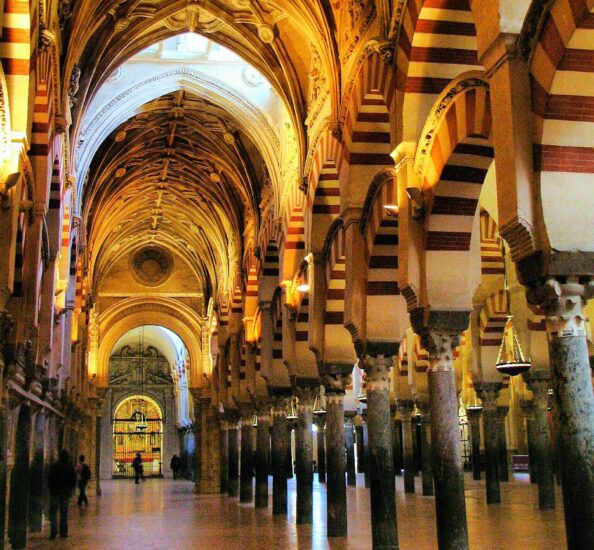
Likewise, I remind you that you have the possibility of making a very special and highly recommended visit to the Mosque of Córdoba.
Night visit of the Mosque of Córdoba
Under the denomination The Soul of Córdoba, It is a night tour of the old mosque, current cathedral, within the framework of a light and sound show.
The Schedules for the night visit to the Mosque of Córdoba They vary depending on the time of year, and on the official website you have the detailed schedules of said visit during the different times of the year, and of the different countries.
The Prices for the night visit to the Mosque of Córdoba They are 18 euros for adults, and 12 euros for seniors+65, disabled people, students up to 26 years old and children from 7 years old (less than 7 years old, free entry).
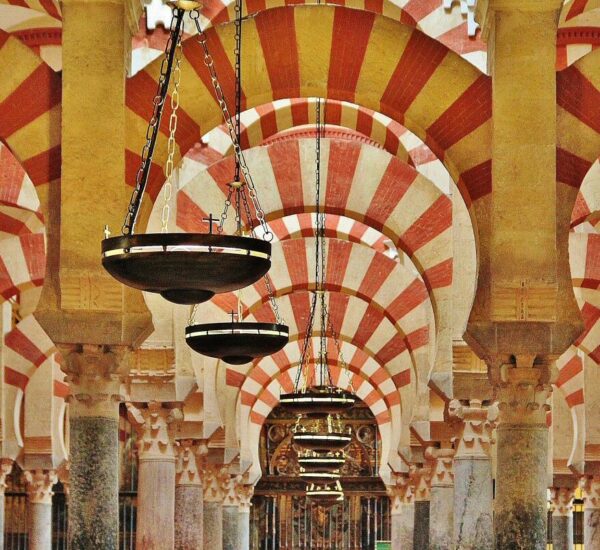


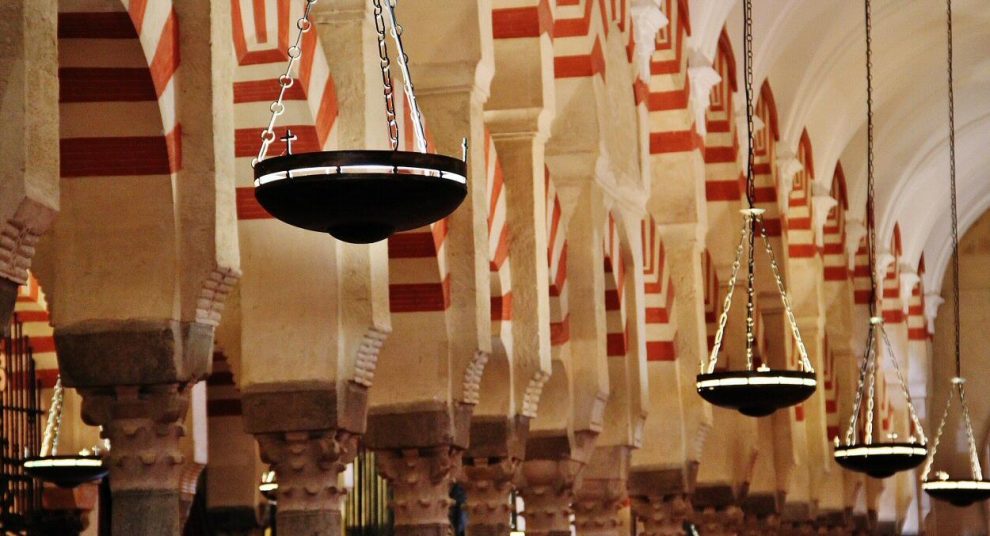

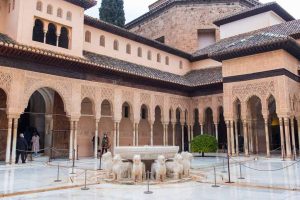
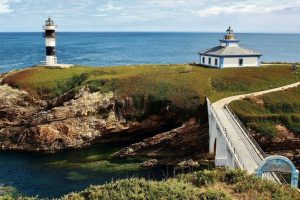











Thanks for the information, I find it very useful and interesting.
I have a question, to visit the mosque for free I have seen that it is from 8:30 to 9:30 a.m., but is it necessary to reserve?
Thank you
Hello, I would like to know if the Cathedral Mosque is open on January 1, 2017. Thank you.
Elena, on January 1, 2018 the mosque is open from 10 a.m. to 18 p.m.
Hello, I would like to know if there is any type of discount for being a University student and having the corresponding ID that identifies you. Thank you so much.
A greeting.
There is some type of discount, for a person with a disability of 49%. Thank you
Cesareo, the official information does not indicate that there is a discount for people with disabilities 🙁
I am about to visit Cordoba, I want to go to the mosque but I can go on a Monday, but that day there are no guided tours, you can still visit
Javiery, indeed, on Mondays you can visit the Mosque of Córdoba on your own, which is open to the public although nighttime guided tours are not offered
Excellent contribution about one of the most beautiful cities in Andalusia, it is a must-see
thanks for the info, it is very useful